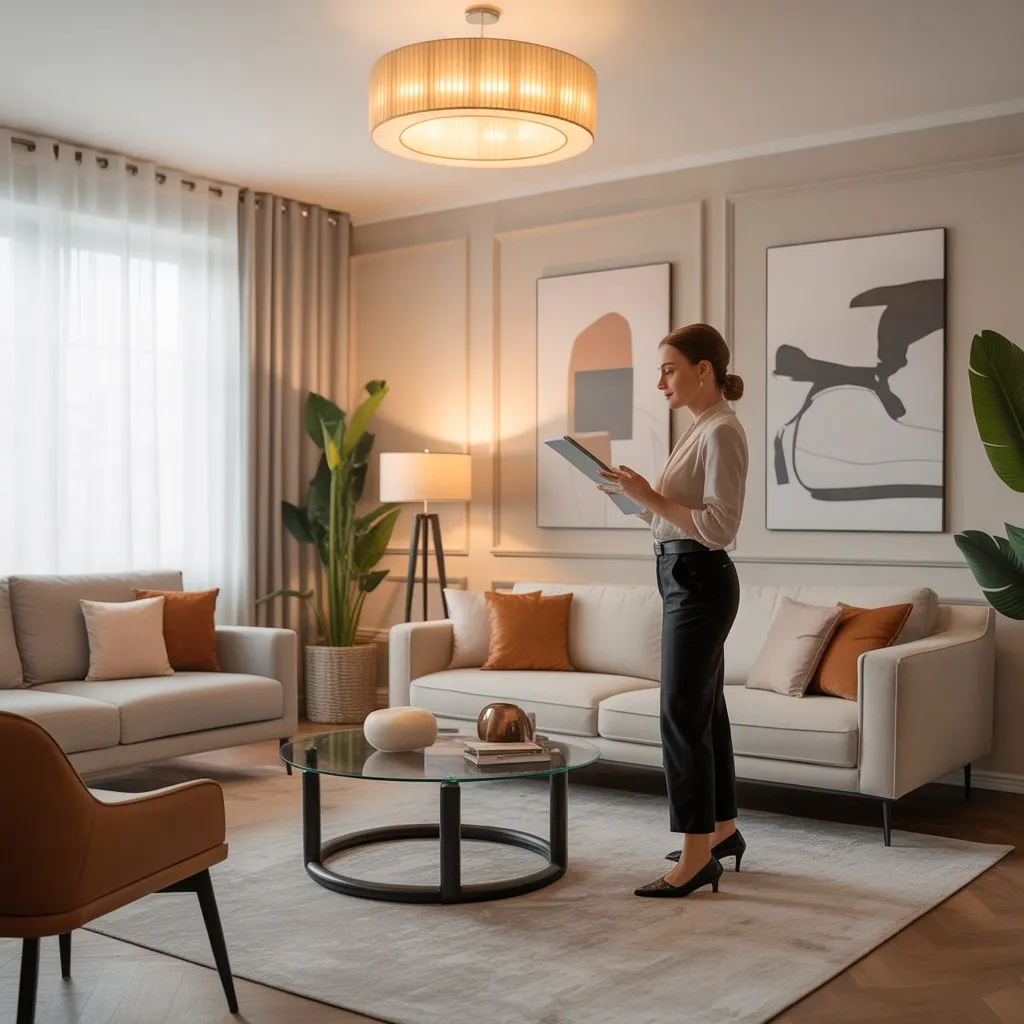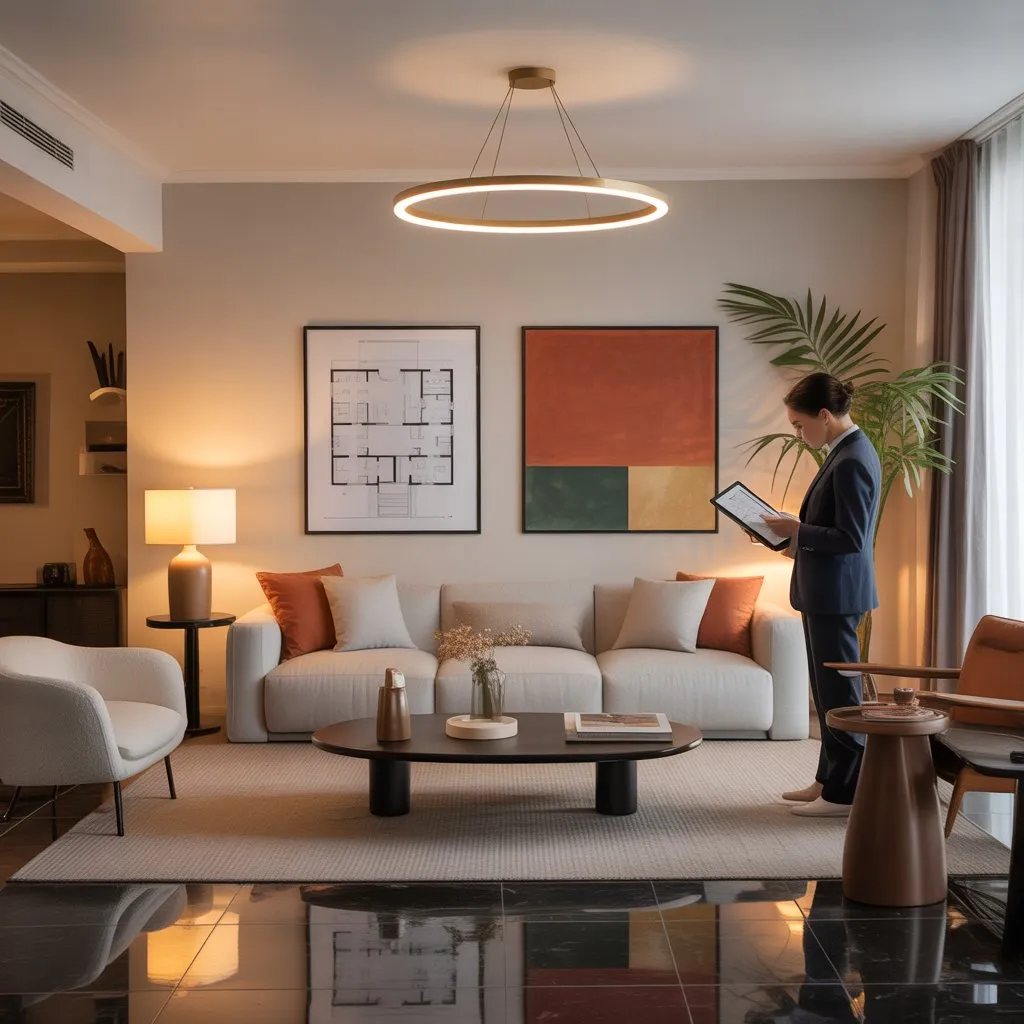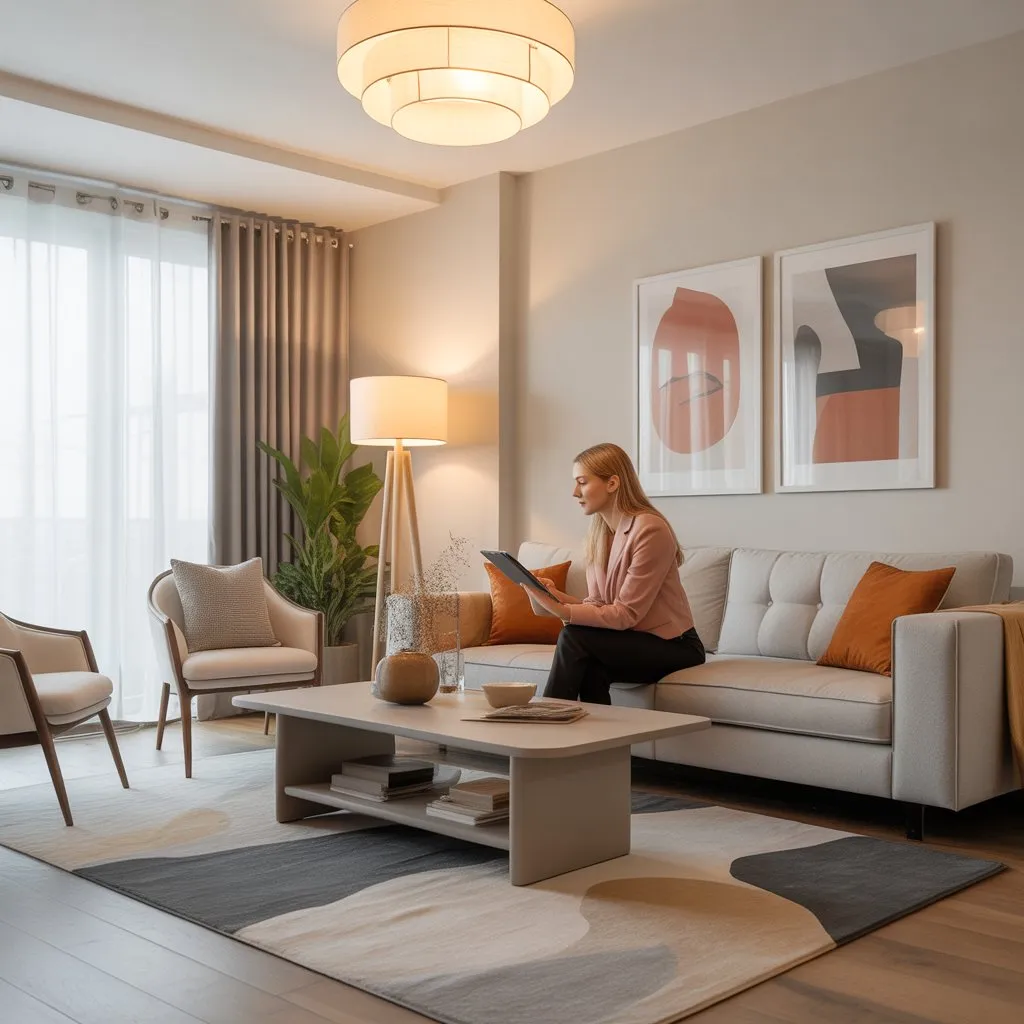Our Location
304 North Cardinal St.
Dorchester Center, MA 02124

The 1980s interior design era was unlike any other in the 20th century. It symbolized a dramatic break from the simplicity of the 1970s, replacing earthy tones and minimal decor with extravagance, energy, and unapologetic style. Across the United States, homeowners began embracing bold color schemes, high-gloss finishes, geometric patterns, and luxury materials that reflected wealth and self-expression.
In the modern design world, the 1980s aesthetic is making a remarkable comeback. From Memphis-inspired furniture to metallic accents and neon lighting, today’s homeowners are reinterpreting this bold era with contemporary sensibilities. The 1980s were a time when interior design celebrated individuality — and that spirit remains highly relevant in today’s design trends.
The 1980s were all about maximalism, energy, and personality. Everything felt bigger, shinier, and more glamorous — from sofas to wall art.
If the 1970s celebrated beige and brown, the 1980s shouted in pinks, purples, and blues. Vibrant color palettes dominated homes, turning every space into a statement.
Common combinations included teal and magenta, black and gold, and pastel pink with gray. These hues appeared on walls, furniture, and even floors, reflecting the decade’s love for artistic drama.

Gloss was everything in the 1980s. Designers used mirrored surfaces, glass tables, and metallic trims to add a futuristic feel. Chrome, brass, and lacquer finishes gave homes a polished, high-end look.
Velvet, silk, and leather upholstery were popular materials that added warmth and sophistication. In many homes, even ceilings or entire walls were covered in mirrored panels to create the illusion of more space.
One of the biggest influences on 1980s interior design came from the Memphis Group, an Italian design collective known for bold geometric shapes, clashing colors, and asymmetrical furniture. This artistic approach transformed living rooms and offices alike into creative masterpieces.
Television shows, music videos, and celebrity homes shaped interior design trends throughout the ‘80s. Shows like Miami Vice inspired pastel coastal interiors, while pop icons like Madonna and Prince popularized metallics and neon lighting.
Art also played a significant role. The works of Keith Haring, Jean-Michel Basquiat, and Andy Warhol encouraged a colorful and rebellious spirit in design. Their use of repetition, graffiti, and pop imagery pushed homeowners to embrace art not just as decoration — but as identity.

The living room was the centerpiece of a 1980s home — a space where luxury met comfort and technology.
Large sectional sofas became the defining furniture piece of the decade. Usually upholstered in leather or plush fabric, these pieces invited relaxation and conversation. Glass-top coffee tables with brass frames, angular shelving units, and mirrored TV stands were equally popular.
Lighting wasn’t just functional — it was an art form. Track lighting, floor lamps, and neon signs gave rooms character. Homes also featured uplighting behind plants or furniture to create a subtle glow that highlighted the architecture.
The overall look was bold but balanced — a combination of Hollywood glamour and futuristic innovation.
Bedrooms in the 1980s reflected both luxury and individuality. The goal was to create a personal sanctuary filled with softness, sophistication, and a touch of drama.
Soft pastels like mauve, blush, and lavender were popular for bedrooms, balanced with glossy black furniture and metallic trims. Accent lighting around mirrors and headboards gave the space a cinematic vibe.
Beds with padded or mirrored headboards were staples. Dressers had curved edges and lacquered surfaces, while mirrored wardrobes enhanced the sense of space.
The ‘80s bedroom felt like a blend of romantic retreat and luxury suite — private yet expressive.

The kitchen and dining areas during this decade were influenced by technology, convenience, and style.
Modern appliances became the pride of every homeowner. Microwaves, food processors, and built-in ovens represented technological progress. Kitchens featured laminate countertops, glossy cabinets, and pastel-colored tiles.
Lighting under cabinets, metallic handles, and tiled backsplashes added futuristic appeal.
Dining spaces emphasized social luxury. Glass-top tables, chrome bases, and velvet dining chairs became centerpieces of elegance.
Chandeliers or pendant lighting often defined the atmosphere, while mirrored walls made the room appear more spacious.
Bathrooms in the 1980s mirrored the luxury of high-end hotels and spas. Large mirrors, jacuzzi tubs, and brass fixtures set the tone for relaxation and indulgence.
Ceramic tiles in mint green, peach, and mauve were extremely popular. Vanities featured laminate countertops with integrated sinks, often paired with gold or brass fittings.
The lighting was soft and warm, usually with globe bulbs around mirrors — a nod to Hollywood dressing rooms.

The modern revival of the 1980s style focuses on balance — capturing the essence of retro glam without making spaces feel cluttered or overwhelming.
Modern designers reinterpret this decade’s excess into sleek sophistication. The result? A nostalgic yet livable design aesthetic that feels fresh and timeless.
While reintroducing retro aesthetics is fun, there are pitfalls to avoid.
Balance is key. You want to evoke the essence of the 1980s — not create a museum of it.
Nostalgia sells — and that’s exactly why the 1980s aesthetic is resurging across American homes. Social media platforms like Pinterest and Instagram have sparked interest in vintage styles, encouraging homeowners to blend old and new aesthetics.
Moreover, the 1980s represent confidence, color, and creativity, all of which resonate with today’s desire for personalization in home design. This revival isn’t about copying — it’s about celebrating boldness.
The beauty of 1980s interior design lies not only in its color palette but also in the materials and textures that defined the decade. The 1980s marked a move away from rustic, natural materials to synthetic glamour — a look that symbolized prosperity and modernity in the United States.
Smooth, shiny surfaces ruled the decade, from lacquered furniture to polished metals. At the same time, plush materials like velvet and suede added comfort and depth.
No discussion of 1980s interior design is complete without acknowledging the Memphis Design Movement, which revolutionized furniture and decor aesthetics. Founded by Italian designer Ettore Sottsass, the movement broke all conventional design rules — mixing shapes, colors, and materials fearlessly.
Memphis design wasn’t subtle; it was loud, experimental, and confident — much like the 1980s spirit itself. In modern interiors, we now see Memphis-inspired accent furniture, patterned tiles, and color-blocked rugs that capture its lively charm in a subtler, refined way.
The resurgence of the 1980s aesthetic across U.S. homes today is not about complete replication — it’s about reinterpretation. Designers are blending vintage inspiration with contemporary comfort.
While neon and bold pastels were dominant in the original decade, today’s designers prefer muted versions. Think sage green instead of mint, or dusty rose instead of hot pink. These tones maintain the retro vibe but with modern subtlety.
One of the most interesting evolutions is the “minimal-maximal” balance — homes that feature a few bold 1980s-inspired pieces within clean, modern spaces. For instance, a Memphis-style chair might sit against a white wall, or a brass lamp may be used as a focal point in an otherwise neutral room.
To achieve a contemporary-retro mix, designers use layered textures — a velvet sofa, a glass table, and patterned rugs — all within balanced color harmony.
The design trends of the 1980s didn’t just emerge from aesthetics — they reflected psychological and cultural change in America.
The decade was marked by economic optimism, technological advancement, and a growing desire for personal expression. Interiors became an extension of identity, where people weren’t afraid to stand out.
Bold colors, extravagant shapes, and flashy finishes gave homeowners a sense of individuality and success. Homes weren’t meant to blend in — they were meant to shine.
Despite the glamour, 1980s homes were still cozy. Plush carpets, deep sofas, and warm lighting created comfort zones in a fast-paced world.
In today’s uncertain times, designers are again turning to the comforting nostalgia of the 1980s — spaces that are both fun and reassuring, encouraging optimism through design.
The living room was the ultimate showcase of 1980s confidence. To recreate it:
Keep lighting ambient with track lights or neon wall accents.
1980s kitchens were sleek yet colorful. Try these modern ideas:
Bathrooms embraced glamour with:
To channel 1980s comfort:
The 1980s design legacy didn’t fade; it evolved. In the 1990s, the aesthetic softened, shifting toward minimalist and neutral styles. However, its core influence — individuality and visual storytelling — stayed strong.
In 2025, American homeowners are reintroducing 1980s interior design through:
Designers now use the 1980s style to express personality in a world dominated by digital minimalism. It’s not about reliving the past — it’s about bringing character back into homes.
Keep large surfaces neutral while adding pops of color through accessories.
One or two standout elements — like a curved sofa or brass floor lamp — are enough to set the tone.
Pair glass and chrome for a futuristic vibe, or velvet and brass for Hollywood-inspired luxury.
Use warm white bulbs and accent lighting to maintain comfort within bold color schemes.
Modern generations see 1980s interior design as a form of rebellion against the ultra-minimalism of recent years. It’s expressive, creative, and nostalgic — three things young designers crave.
Platforms like TikTok and Instagram have amplified the 1980s revival. Aesthetic trends such as #RetroRevival and #80sHomeDecor highlights how well this bold design photographs and performs online.
Unlike modern high-end decor, many 1980s-inspired pieces can be thrifted, refurbished, or DIYed, making the style accessible to younger homeowners.
While the original 1980s design often celebrated consumerism, today’s reinterpretation emphasizes sustainability. Designers now use:
This blend of eco-conscious design and retro style gives 1980s interiors a timeless edge for the modern American home.
The 1980s interior design movement was daring, glamorous, and unapologetically individualistic. Its modern revival shows that boldness never truly goes out of style.
Today’s homes blend retro textures, artistic expression, and sustainable choices — proving that the ‘80s weren’t just about excess, but about creativity and personality.
When integrated thoughtfully, 1980s elements bring energy and nostalgia to any room — celebrating an era that continues to inspire American interior design decades later.
1980s interior design is characterized by bold colors, geometric patterns, mirrored surfaces, and luxurious materials. It blends modernism with glamour, featuring neon lights, lacquered furniture, and metallic finishes.
Bright colors like teal, fuchsia, mauve, and black were trendy in the 1980s. These were often paired with metallics, glass, and white to create a futuristic yet vibrant look.
Chunky, oversized furniture with curved lines, glossy finishes, and bold upholstery was popular. Leather sofas, mirrored coffee tables, and modular seating were key staples.
You can mix retro décor with modern pieces by adding neon lights, abstract art, chrome accents, and geometric shapes. Focus on statement furniture and vibrant color palettes.
Materials like chrome, glass, lacquer, velvet, and plastic were iconic. These elements added both shine and luxury to interiors.
No — 1980s design was the opposite of minimalism. It celebrated maximalism, featuring bold patterns, dramatic colors, and layered textures.
Track lighting, neon fixtures, and geometric pendant lamps were common. Lighting was often used decoratively to enhance visual drama.
Pop art, Memphis-style graphics, and abstract geometric art were major trends. These styles added a sense of energy and creativity to the space.
Yes, wallpapers were widely used — often with abstract patterns, pastel tones, or metallic finishes. It was an easy way to make walls stand out.
Carpeted floors in pastel shades were common, as were black-and-white tiles and vinyl flooring for kitchens and bathrooms.
Use mirrors, glossy furniture, and bright accents to create an illusion of space. Keep the layout open and use reflective surfaces to bounce light.
Shop for vintage furniture, use neon LED lights, hang retro posters, and choose metallic accessories. You can easily achieve the look without a full renovation.
The nostalgic appeal, bold creativity, and energetic colors of the 1980s are making a comeback in modern design, blending vintage charm with modern comfort.
Velvet, leather, glass, and polished metals were common. Designers loved the contrast between shiny and soft materials.
Absolutely. By balancing key retro elements — like geometric art, neon accents, and sleek furniture — you can achieve a stylish, nostalgic modern space.
Related Article: Stunning 70s Interior Design Ideas for Modern Homes